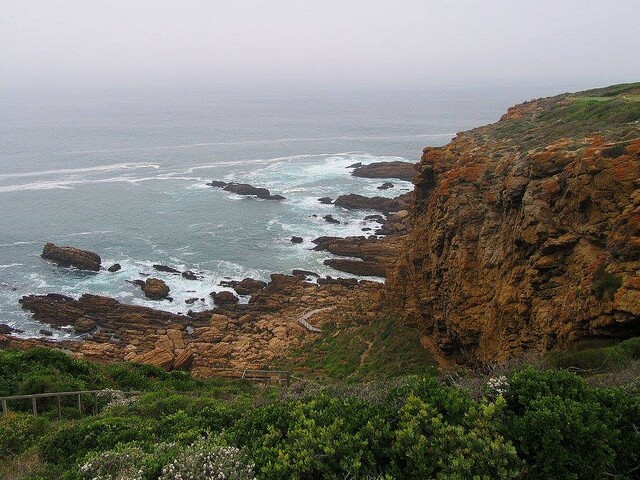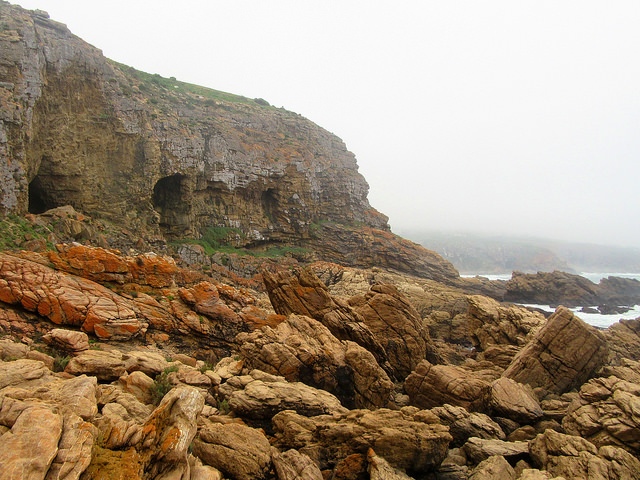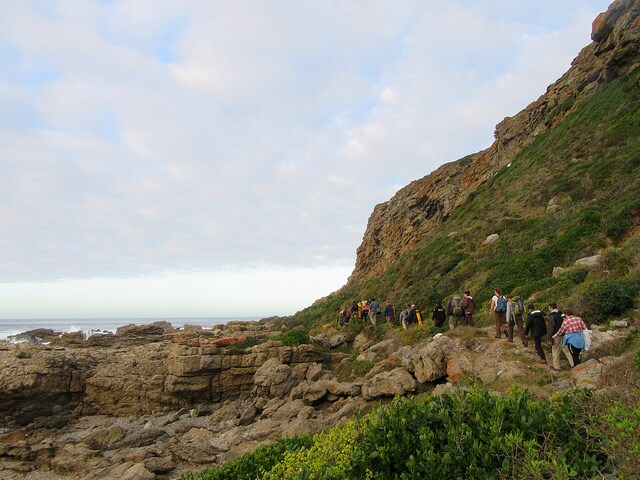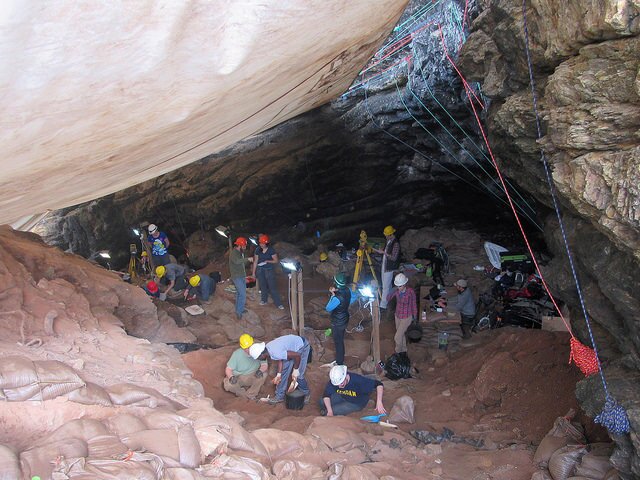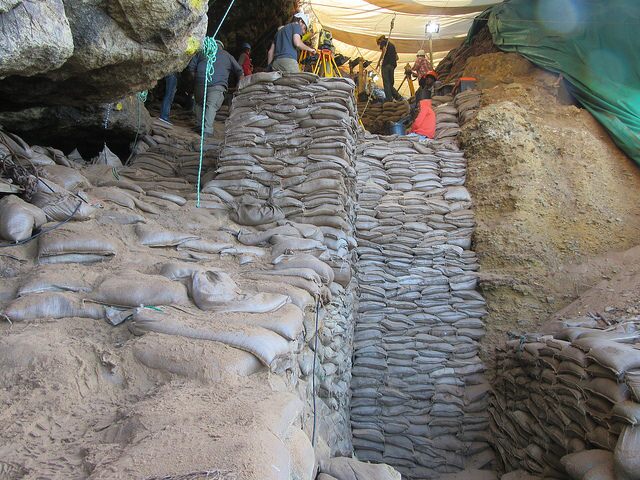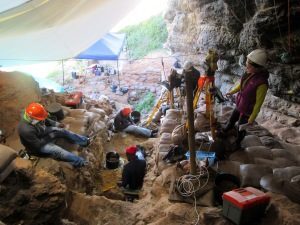
In this place, you can peer out over a grand oceanic vista. Standing on the top of a cliff and looking down, you see waves crash against rugged rock formations of various hues of brown—natural stone monuments sculpted by wind, water and time. If you look more closely, you can see dolphins among the waves and seals on the rocks. It’s perfect coastal hiking territory.
The coast of northern California?
Think again.
You’re on the southeastern coast of South Africa, on a rocky headland called Pinnacle Point just south of the town of Mossel Bay.
Other than its majestic scenery, Pinnacle Point would mean little to most people. But for archaeologists and others who know about its significance, it is one of a number of locations where evidence has been found bearing on the dawn of modern humans. People lived here as long ago as 100,000 years and more—near the beginnings of modern humanity, as the current thinking goes. (Archaeological and genetic research has shown that the first modern humans likely arose about 160,000 to 200,000 year ago).
For almost countless millennia to the present, cave shelters have helped to define the coastline cliffs here. They have also helped to define a relatively good living for prehistoric people. One of these shelters, designated by archaeologists as ‘PP13B’, was first excavated more than a decade ago by an international team under the direction of palaeoanthropologist Curtis Marean of the Institute of Human Origins at Arizona State University. He and his team are still excavating at Pinnacle Point, which also includes a second cave shelter known as PP 5-6. Between the two shelters, scientists have uncovered a wealth of information that has enlightened current understanding about what kind of people these early occupants were and what they could tell us about human evolution and human behavior tens of thousands of years ago. (Shown above, team excavating at a Pinnacle Point cave shelter. Andrew Hall, Wikimedia Commons)
___________________________________________
View looking down at the Pinnacle Point cave shelter area. Courtesy Kate Leonard
__________________________________________________________
View of Pinnacle Point cave shelters. Courtesy Kate Leonard
_______________________________________________________
View toward the ocean looking out of a cave shelter at Pinnacle Point. Courtesy Kate Leonard
_____________________________________________________
Kate’s brush with prehistory
For a brief time in early 2016, Kate Leonard, a young Canadian PhD-credentialed archaeologist, joined the team as part of her global year-long journey to work at twelve different archaeological sites in 12 separate countries. She calls her project Global Archaeology: A Year of Digs. Popular Archaeology has been following her on her journey as she makes her rounds across the world. Pinnacle Point now makes the 5th stop on her global trek.
As part of any dig crew, Leonard knows that there are sometimes a few challenges that come with the outdoor experience of a dig, and Pinnacle Point was no exception. “To reach the site itself,” says Leonard, “the team walks down a long wooden staircase — that can be a bit slippery after a rainfall — and along the coastline. After a long day of digging it can be daunting to look up at all those steps with your frame-pack loaded with archaeological gear. Because the site is inaccessible except by foot much of the valuable equipment has to be trekked in and out by the team members.”
But there are benefits.
“A very positive aspect of this trek is the beautiful view over the Indian Ocean: it was wonderful to see the sunrise over the waves as we headed to the site in the morning,” she adds. But even more satisfying, as Leonard would be the first to say, is the opportunity to be a critical part of a major scientific investigation at a site that is having a salient impact on our understanding of human evolution. Archaeology at Pinnacle Point has been one of those undertakings leading the way. “All archaeological investigations are important and further our understanding of why humans do the things we do,” Leonard states. “But to be revealing evidence of human activity from so long ago is an even greater responsibility.”
Unlike excavating great ancient monumental structures of more recent human history, the investigation and retrieval of evidence of human occupation at prehistoric sites require recognizing and recovering objects and material that are generally far more subtle. It often requires the application of advanced techniques in the most careful way possible. “Archaeology is ‘preservation through destruction’: you only get one chance to put your trowel in the ground because after you remove the archaeological material it can never be put back,” explains Leonard. “That is why the work of recording the excavation process is so essential. At Pinnacle Point the level of detail being recorded is truly astounding. We plot every ‘find’ with no size restriction – so even pieces of shell that are 0.25 cm in size are digitally mapped with the total station [a high-tech piece of survey equipment that makes digital 3D maps]. This creates a rich database of information that can be intensively analyzed. When over 50,000 artifacts are being collected over the course of one field season precision and organization is paramount!”
Unique to the Pinnacle Point excavation is the integration of bar code scanners to record artifacts, archaeological features and buckets of sieved soil. The scanners are connected to hand-held computers, which are in turn connected to a total station. Currently, the excavation team is focusing on shelter PP 5-6, where they have set up 5 total stations with two team members functioning as site recorders moving among the excavators to carefully record the data with tablets. “There is a lot riding on the site recorders,” says Leonard, who worked as one of the recorders. “They have to ensure that all data is logged correctly and nothing is left out. It is amazing to see the activity on site with excavators furiously digging, the site recorders moving between their workstation and the excavators, and the 5 total stations being run simultaneously to keep up with the amount of archaeology being revealed.”
__________________________________________
The team walking to the site in the morning. Courtesy Kate Leonard
_______________________________________________________
Pinnacle Point (PP) Cave 5-6 (left). Courtesy Kate Leonard
______________________________________________________
The team working at the lower end of the excavation in PP 5-6. Courtesy Kate Leonard
___________________________________________
The team at work in the upper portion of the excavation. Courtesy Kate Leonard
____________________________________________________________
A view of the long section in PP 5-6. This shows 40,000 years of stratigraphy. The base yielded material from 90,000 years ago. Courtesy Kate Leonard
___________________________________________________________
The finds and what they mean
Exploration at Pinnacle Point has taken scientists to a series of cave shelter sites. But the two cave shelters, PP13B and PP5-6, have stood out most prominently in the ongoing investigations. Cave PP13B alone has provided a glimpse of the surprisingly early sophistication and innovation of our modern human ancestors. “It has given us the earliest evidence for human consumption of shellfish – dated to around 164,000 years ago,” says Leonard. “Shellfish collecting can only be done at low spring tide (a new and full moon) and therefore a knowledge/awareness of the lunar cycle is implied. Once this knowledge began to be implemented to harvest shellfish the people living at Pinnacle Point had a predictable source of calorie rich protein with which to supplement their diet.” Cave PP13B also contained evidence for early use of ochre pigment and heat treatment of stone artifacts.” (See videos below — and wait during the momentary pauses within each video for the following video session).
Cave shelter PP5-6, where the team is now working, has added yet more. Containing material dated from 50,000 to 90,000 years ago, it has provided the earliest known evidence for the knapping of microliths to make composite tools, including intentional heat treatment of the stone. “This may be the earliest evidence for projectile points around 71,000 years ago, and to make those microliths they focused on heat treatment to improve the stone,” Leonard adds. Using the controlling elements of simple hearths, the shelter occupants employed a complex process to heat the stone (in this instance silcrate) and thus change its properties for better flaking to produce the micro blades or microliths for more advanced toolmaking. Many scientists consider this to be the foundation for pyrotechnology and a precursor to later technologies, such as the making of ceramics and the manufacturing of metals.
And that’s not all. “The types of innovations that have been revealed by the excavations in the Pinnacle Point complex share some major traits: cooperation, organization and planning,” says Leonard. And these were critical to the later development of agriculture and urbanization, basic elements of civilization.
Moving on
Although the work at Pinnacle Point will likely go on for seasons to come, for Leonard, her global trek has led north to Naxos, Greece, the next stop on her year-long journey. There will be more on this to come.
Popular Archaeology will be following and reporting on Leonard’s worldwide experiences periodically throughout 2016 as she hops from one location to another during her global journey. To continue the work, however, Leonard will need financial support from donors. Readers interested in reading about and supporting her self-directed Global Archaeology crowdfunded project can learn more at gofundme.com/globalarchaeology.
See more about Leonard’s experience at Pinnacle Point here.
(Above, at rest from work, Kate enjoys a majestic view at Pinnacle Point).
_________________________________________
_______________________________________________________
_______________________________________________________

______________________________________________
Travel and learn with Far Horizons.
____________________________________________
This richly illustrated issue includes the following stories: Recent findings shedding new light on the whereabouts of the remains of Philip of Macedon, father of Alexander the Great; how an archaeologist-sculptor is bringing bones of the dead back to life; archaeologists uncovering town life at the dawn of civilization; an exclusive interview with internationally acclaimed archaeologist James M. Adovasio about what makes the Meadowcroft Rockshelter prominent in the ongoing search for the first Americans; what archaeologists are finding at the site of the ancient city of Gath, the home town of the biblical Philistine giant, Goliath; and how scientists are redrawing the picture of human evolution in Europe. Find it on Amazon.com.


